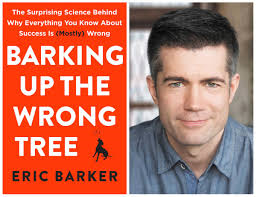Barking Up the Wrong Tree: The Surprising Science behind Why Everything You Know about Success Is (Mostly) Wrong
Summary written by: Ruth Angulo Bomar, Ph.D.
“Sometimes what produces success is raw talent, sometimes it’s the nice things our moms told us to do, and other times it’s the exact opposite. Which old sayings are true and which are myths?”
-Barking up the Wrong Tree, page 3
Author and blogger, Eric Barker , showcases his insatiable appetite for knowledge and support from empirical evidence in his recent book Barking Up the Wrong Tree. For this recent doctoral graduate, it was a refreshing break from APA style notation. The author artfully interweaves stories of real humans with research results to shake up the reader from default heuristics. First, he presents one side of the coin then an opposing view of the same idea, debunking both sides, much like the TV court scene battles between defense attorney and the prosecuting district attorney. In six chapters, Barker unceremoniously dismantles some commonly held beliefs about success by challenging the following ideas:
- Should we play it safe and do what we’re told if we want to succeed?
- Do nice guys finish last?
- Do quitters never win and winners never quit?
- It’s not what you know. It’s who you know (unless it really is what you know).
- Believe in yourself, sometimes.
- Work, work, work or work-life balance.
This summary will focus on life’s contradiction of when to grit and when to quit.
Do quitters never win and winners never quit?
“…so we know where to start, when to quit, when to show grit, and how to ultimately get where we want to go.”
-Barking up the Wrong Tree, page 116
The city of Toronto has been trying to cope with their domesticated wildlife neighbors, the raccoons, for years. The Toronto raccoon shows a level of grit and resourcefulness that is immeasurable and has cornered this Canadian city’s residents into the role of victims. Suzanne MacDonald, a researcher who studies raccoon behavior at York University, says, Raccoons in the city are extraordinary not only in their ability to approach things, but they have not fear, and they stick with it, they will spend hours trying to get food out of something.
Every attempt to curb these critters has failed. The folks of Toronto have employed techniques to protect their garbage ranging from strapping down the lids of trashcans to concealing the bins but with no avail. In 2015, the city even spent $31 million dollars to create a new, redesigned raccoon-proof trash can. These furry thieves have thrived in the face of human expansion. These nocturnal bandits exhibit many principles of success discussed in this chapter. Optimism, focus, trial-and-error.
Barker suggests we learn from these little rascals. Instead of seeing insurmountable problems, you can be like a Toronto raccoon and see how the challenges to overcome will make you smarter and more successful.
The three main points below offer ways for you to become as unstoppable as a Toronto raccoon but so successful you won’t have to eat out of trashcan.
What’s the plan?
What’s a system that will work whenever you’re trying to turn dreams into reality. After concluding that positive thinking, by itself doesn’t work, Gabriele Oettingen, a psychologist of New York University, came up with an easy system called WOOP (the formal term is mental contrasting). Wish. Outcome. Obstacles. Plan. The W for wish verbalize your dream. The O for Outcome crystalizes your wish so you can see the outcome of your desire. The O for obstacles forces you to look at reality. What are the obstacles? And finally, let’s get to work, P for planning. WOOP doesn’t work for everybody. It does give a motivational boost when your goal is something you can achieve but it doesn’t if your goal is outside the realm of possibility.
WOOP will give you a plan and energy to carry it out. (page 115)
When does pessimism pay off?
Pessimists tell themselves that bad events will last a long time or forever; are universal; and are their own fault. Whereas optimists tell themselves that bad events are temporary; have a specific cause and aren’t universal; and are not their fault.
Mark Seligman found that when you shift from pessimistic to optimistic it makes you feel better and you become grittier. (page 71)
The problem with pessimists is that they are often right. Seligman developed an optimism-pessimism balance called flexible optimism. A little pessimism keeps us honest. So when does optimism pay off? When the risks are very low (like most things in life) or when payoffs are very high (like a career you might want to devote your life to). When does pessimism payoff? When things seem high risk and low reward.
Quitting is often an issue of limits.
Mihaly Csikszentmihalyi, researcher of flow was studying the most creative successful people of the world. He contacted 275 Nobel Prize winners, National Book Award winner and other people at the top of the fields. So what happened? Over one third of them said no. Many didn’t reply. They had their own work to do. One of the secrets to productivity is saying no. Jim Collins, author of Good to Great, conducted a study of companies that turned themselves around from failure to success. The biggest changes these companies did weren’t new initiatives but about the bad things they needed to stop doing. Research shows that when we choose to quit pursuing unattainable goals, we’re happier, less stressed and get sick less often.
Get rid of the activities that provide little value and don’t serve your goals. Then add those hours to fuel progress toward the big things that matter. (page 121)
Eric Barker with his penchant for knocking over sacred cows turns our regular thinking about success upside down. When to grit and when to quit is one of the success oxymorons he unpacks.

